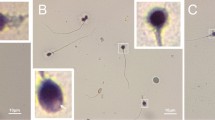Abstract
Purpose
The aim of this study is to identify potential genes involved in human globozoopsermia.
Methods
Nineteen globozoospermic patients (previously screened for DPY19L2 mutations with no causative mutation) were recruited in this study and screened for mutations in genes implicated in human globozoospermia SPATA16 and PICK1. Using the candidate gene approach and the determination of Spata16 partners by Glutathione S-transferase (GST) pull-down four genes were also selected and screened for mutations.
Results
We identified a novel mutation of SPATA16: deletion of 22.6 Kb encompassing the first coding exon in two unrelated Tunisian patients who presented the same deletion breakpoints. The two patients shared the same haplotype, suggesting a possible ancestral founder effect for this new deletion. Four genes were selected using the candidate gene approach and the GST pull-down (GOPC, PICK1, AGFG1 and IRGC) and were screened for mutation, but no variation was identified.
Conclusions
The present study confirms the pathogenicity of the SPATA16 mutations. The fact that no variation was detected in the coding sequence of AFGF1, GOPC, PICK1 and IRGC does not mean that they are not involved in human globozoospermia. A larger globozoospermic cohort must be studied in order to accelerate the process of identifying new genes involved in such phenotypes. Until sufficient numbers of patients have been screened, AFGF1, GOPC, PICK1 and IRGC should still be considered as candidate genes.

Similar content being viewed by others
References
Dam AH, Koscinski I, Kremer JA, Moutou C, Jaeger AS, Oudakker AR, et al. Homozygous mutation in SPATA16 is associated with male infertility in human globozoospermia. Am J Hum Genet. 2007;81(4):813–20.
Krachler AM, Sharma A, Kleanthous C. Self-association of TPR domains: lessons learned from a designed, consensus-based TPR oligomer. Proteins. 2010;78(9):2131–43.
Xu M, Xiao J, Chen J, Li J, Yin L, Zhu H, et al. Identification and characterization of a novel human testis-specific Golgi protein, NYD-SP12. Mol Hum Reprod. 2003;9(1):9–17.
Elinati E, Kuentz P, Redin C, Jaber S, Vanden Meerschaut F, Makarian J, et al. Globozoospermia is mainly due to DPY19L2 deletion via non-allelic homologous recombination involving two recombination hotspots. Hum Mol Genet. 2012;21(16):3695–702.
Liu G, Shi QW, Lu GX. A newly discovered mutation in PICK1 in a human with globozoospermia. Asian J Androl. 2010;12(4):556–60.
Christensen GL, Ivanov IP, Atkins JF, Campbell B, Carrell DT. Identification of polymorphisms in the Hrb, GOPC, and Csnk2a2 genes in two men with globozoospermia. J Androl. 2006;27(1):11–5.
Xiao N, Kam C, Shen C, Jin W, Wang J, Lee KM, et al. PICK1 deficiency causes male infertility in mice by disrupting acrosome formation. J Clin Invest. 2009;119(4):802–12.
Kang-Decker N, Mantchev GT, Juneja SC, McNiven MA, van Deursen JM. Lack of acrosome formation in Hrb-deficient mice. Science. 2001;294(5546):1531–3.
Yao R, Ito C, Natsume Y, Sugitani Y, Yamanaka H, Kuretake S, et al. Lack of acrosome formation in mice lacking a Golgi protein, GOPC. Proc Natl Acad Sci U S A. 2002;99(17):11211–6.
Ghedir H, Ibala-Romdhane S, Okutman O, Viot G, Saad A, Viville S. Identification of a new DPY19L2 mutation and a better definition of DPY19L2 deletion breakpoints leading to globozoospermia. Mol Hum Reprod. 2016;22(1):35–45.
Okutman O, Muller J, Baert Y, Serdarogullari M, Gultomruk M, Piton A, et al. Exome sequencing reveals a nonsense mutation in TEX15 causing spermatogenic failure in a Turkish family. Hum Mol Genet. 2015;24(19):5581–8.
Schoenberg DR, Maquat LE. Regulation of cytoplasmic mRNA decay. Nat Rev Genet. 2012;13(4):246–59.
Pirrello O, Machev N, Schimdt F, Terriou P, Menezo Y, Viville S. Search for mutations involved in human globozoospermia. Hum Reprod. 2005;20(5):1314–8.
Kuentz P, Vanden Meerschaut F, Elinati E, Nasr-Esfahani MH, Gurgan T, Iqbal N, et al. Assisted oocyte activation overcomes fertilization failure in globozoospermic patients regardless of the DPY19L2 status. Hum Reprod. 2013;28(4):1054–61.
Acknowledgements
We would like to thank James Turner for his critical reading of the manuscript. We are grateful to the Institute of Genetics and Molecular and Cellular Biology (IGBMC) platforms. The study was funded by Agence Nationale de la Recherche and l’Agence de BioMédecine. This work was supported by the French Centre National de la Recherche Scientifique (CNRS), Institut National de la Santé et de la Recherche Médicale (INSERM), the Ministère de l’Education Nationale et de l’Enseignement Supérieur et de la Recherche, the University of Strasbourg, the University Hospital of Strasbourg, the Agence Nationale pour la Recherche and the Agence de la BioMédecine.
Author information
Authors and Affiliations
Corresponding author
Ethics declarations
This study was approved by the local Ethical Committee (Comité de protection de la personne, CPP (CPP 09/40 - W AC-2008-438 1W DC-2009-I 002)) of Strasbourg University Hospital. For each case analysed, informed written consent was obtained according to the CPP recommendations.
Additional information
Capsule In this study, we confirmed the pathogenicity of SPATA16 mutations and we identified potential genes implicated in human globozoospermia.
Electronic supplementary material
Below is the link to the electronic supplementary material.
Table S.1
(DOCX 18 kb)
Table S.2
(DOCX 24 kb)
Table S.3
(DOCX 23 kb)
Table S.4
(DOCX 27 kb)
Table S.5
(DOCX 17 kb)
Figure 1
GST pull-down. GST-SPATA16 fusion protein (lane 1) and control GST protein (lane 2) were subjected to pull-down reaction in the presence of cell extract derived from adult mice testes. The samples were fractionated in SDS-PAGE and stained with silver. (GIF 75 kb)
Figure 2
Linkage analysis. (A) SNP array results revealing a unique homozygous region shared between the brothers of the three families. The genes located in the region of 4.7 Mb on the chromosome eight are represented in the table below it. (B) SNP array results showing the two brothers of family B sharing a homozygous region for IRGC locus (loc.chr19: 43,716,010 – 43,720,021). (GIF 58 kb)
Rights and permissions
About this article
Cite this article
ElInati, E., Fossard, C., Okutman, O. et al. A new mutation identified in SPATA16 in two globozoospermic patients. J Assist Reprod Genet 33, 815–820 (2016). https://doi.org/10.1007/s10815-016-0715-3
Received:
Accepted:
Published:
Issue Date:
DOI: https://doi.org/10.1007/s10815-016-0715-3




